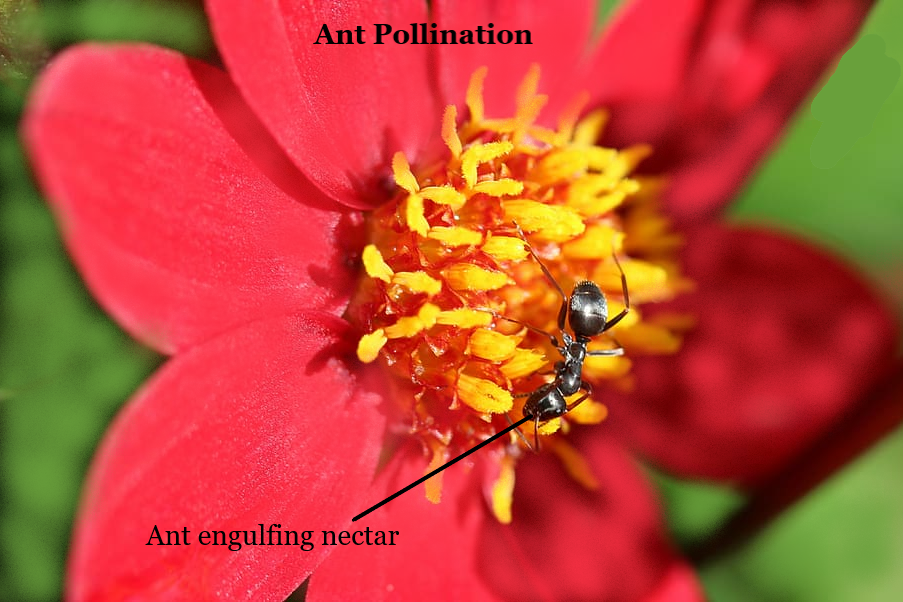
Which of the following terms describes pollination by the agency of ants?
(a)Chiropterophily
(b)Entomophily
(C)Ornithophily
(d)Myrmecophily
Answer
582k+ views
Hint: Chiropterophily is the term used for pollination brought about by the bats while the term entomophily is used for pollination that is caused by insects.
Complete answer:
The term myrmecophily describes pollination by the agency of ants. The term myrmecophily is employed for positive interspecies associations between ants and other organisms like plants, other arthropods, and fungi. Ants form a gaggle of social insects that are great lovers of nectar. These insects are very busy, often observed visiting different flowers to gather energy-rich nectar. Ants are wingless and therefore they must crawl into each flower to get the nectar. Ants are more likely to require nectar without effectively cross-pollinating flowers.
Not all ants always pollinate flowers. Researchers have found that some sort of chemical is secreted by the ants that acts as an antibiotic. This chemical substance is responsible for the protection of ants from bacterial or fungal infections. Unfortunately, for the flowers which are visited by these ants, this secretion also affects the viability of the pollen grains and when the pollen grains come in contact with this chemical. Such pollen grains often fail to initiate post-pollination events.

So, the correct answer is, ’myrmecophily’.
Note:
1. Ants visit inconspicuous, low-growing flowers positioned on the brink of the stem. samples of ant-pollinated plants in North America include Small's stonecrop (Diamorpha smallii), alpine navelwort (Paronychia pulvinata), and Cascade knotweed (Polygonum cascadense).
2. Flowers that will be easily visited by ants are typically low growing plants having small inconspicuous flowers and have flowers that are very on the brink of the stem.
Complete answer:
The term myrmecophily describes pollination by the agency of ants. The term myrmecophily is employed for positive interspecies associations between ants and other organisms like plants, other arthropods, and fungi. Ants form a gaggle of social insects that are great lovers of nectar. These insects are very busy, often observed visiting different flowers to gather energy-rich nectar. Ants are wingless and therefore they must crawl into each flower to get the nectar. Ants are more likely to require nectar without effectively cross-pollinating flowers.
Not all ants always pollinate flowers. Researchers have found that some sort of chemical is secreted by the ants that acts as an antibiotic. This chemical substance is responsible for the protection of ants from bacterial or fungal infections. Unfortunately, for the flowers which are visited by these ants, this secretion also affects the viability of the pollen grains and when the pollen grains come in contact with this chemical. Such pollen grains often fail to initiate post-pollination events.

So, the correct answer is, ’myrmecophily’.
Note:
1. Ants visit inconspicuous, low-growing flowers positioned on the brink of the stem. samples of ant-pollinated plants in North America include Small's stonecrop (Diamorpha smallii), alpine navelwort (Paronychia pulvinata), and Cascade knotweed (Polygonum cascadense).
2. Flowers that will be easily visited by ants are typically low growing plants having small inconspicuous flowers and have flowers that are very on the brink of the stem.
Recently Updated Pages
Why are manures considered better than fertilizers class 11 biology CBSE

Find the coordinates of the midpoint of the line segment class 11 maths CBSE

Distinguish between static friction limiting friction class 11 physics CBSE

The Chairman of the constituent Assembly was A Jawaharlal class 11 social science CBSE

The first National Commission on Labour NCL submitted class 11 social science CBSE

Number of all subshell of n + l 7 is A 4 B 5 C 6 D class 11 chemistry CBSE

Trending doubts
Differentiate between an exothermic and an endothermic class 11 chemistry CBSE

10 examples of friction in our daily life

One Metric ton is equal to kg A 10000 B 1000 C 100 class 11 physics CBSE

Difference Between Prokaryotic Cells and Eukaryotic Cells

1 Quintal is equal to a 110 kg b 10 kg c 100kg d 1000 class 11 physics CBSE

State the laws of reflection of light




